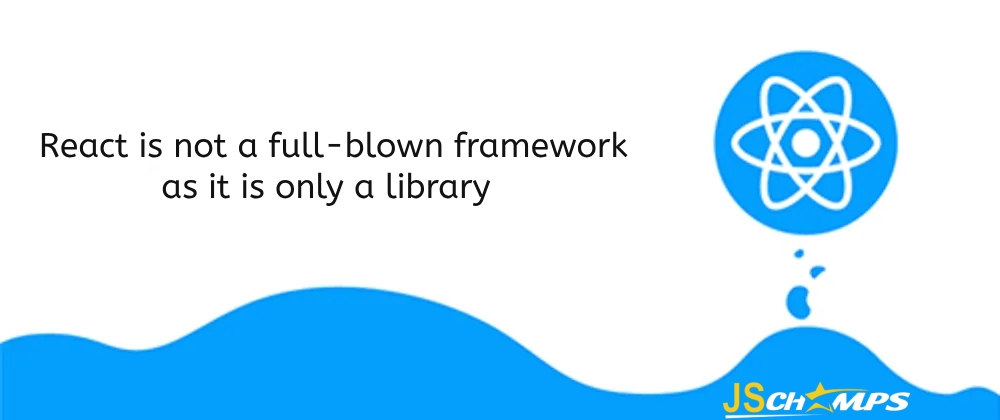
What are the limitations of React.js
React.js is a widely used JavaScript library for building Interactive UI with reusable components, and it has proven to be powerful and flexible. It has so many simple and efficient features. We’ve known the major pros of using React, from its reusable components and high-performance capabilities to its easy-to-learn syntax and SEO friendliness. However, like any technology, it also has some limitations.
Limitations of React JS :
- Not a full-blown framework but a library like JQuery.
- Most of the time it is difficult for beginner programmers to understand React.
- JSX Complexity
- Lack of Proper Documentation
- Development Speed
- Problems With SEO
1. Not a full-blown framework but a library like JQuery :-

React is a library for building user interfaces. It is not a full-blown framework like Angular or Vue, which come with many built-in tools and resources to help developers build complete web applications.React is written in JavaScript and is used to make better JavaScript applications .While it provides powerful state management tools via hooks and other features, it does not include many of the React-specific libraries you’re going to need for most projects . This means that as a React developer, you must choose the tools on your own
2-Most of the time it is difficult for beginner programmers to understand React.

React, while powerful, can be challenging for beginner programmers due to its unique concepts and the shift in paradigm it introduces. The JSX syntax, which combines HTML-like tags with JavaScript, can initially confuse those unfamiliar with this hybrid approach. The concept of building applications through components, a core tenet of React, might be a departure from the more procedural style of coding that beginners are accustomed to.
Understanding the unidirectional data flow in React, where data changes follow a specific path, can be a conceptual hurdle for newcomers. The virtual DOM, a performance optimization feature, adds another layer of complexity as beginners grapple with the idea of a virtual representation of the actual DOM.
Setting up a React project involves build tools and configuration, which might be overwhelming for beginners who are not yet familiar with these aspects of web development. Additionally, while React provides local state management within components, more intricate state management solutions like Redux may be needed for larger applications, adding an extra layer of complexity.
Despite these challenges, many beginners find that gradually working through simpler projects, seeking guidance from tutorials, and engaging with the supportive React community can ease the learning curve and help them gain proficiency with React over time.
3.Coding might become complex as it will make use of inline templating and JSX.

React.js limitations, Coding in React introduces complexities, especially for those new to the library, due to the use of inline templating and JSX (JavaScript XML). JSX, a syntax extension that allows mixing HTML-like tags with JavaScript code, can initially be perplexing for developers more accustomed to traditional HTML and JavaScript separation. This inline templating approach challenges conventional practices by blending the presentation logic with the application’s business logic.
While JSX enhances the readability of the code and facilitates the creation of dynamic user interfaces, it introduces a layer of abstraction that may be challenging for beginners to grasp. Deciphering how JSX translates to JavaScript and understanding the virtual DOM it operates on adds an extra layer of complexity.
Moreover, the integration of logic within components can make the codebase more intricate. React’s component-based architecture encourages the creation of modular, reusable units, but for beginners, managing the state and understanding the flow of data between these components can be daunting.
Despite these challenges, JSX and inline templating in React offer advantages in terms of code maintainability and component reusability. As developers become more accustomed to these concepts, the initial complexity often transforms into an appreciation for the streamlined and expressive nature of React development.
4.jsx complexity

React.js limitations, While JSX is generally regarded as an asset by the majority, it can also pose a challenge for some. Despite its ability to enhance code readability and cleanliness, JSX’s integration of HTML and JavaScript elements introduces complexity that may befuddle those less acquainted with it.
In essence, JSX serves as a JavaScript extension designed to improve code expressiveness. However, the amalgamation of HTML and JavaScript within JSX may render React JS more intricate for learners, potentially discouraging aspiring developers. Complaints from developers and designers often revolve around the perceived complications associated with mastering JSX, contributing to a steeper learning curve.
4. Lack of Propеr Documеntation:- The React ecosystem boasts a myriad of tools and libraries such as Redux and Reflux, designed to enhance performance. React itself undergoes regular updates, which, while beneficial, presents a drawback. Some developers express concerns that the rapid pace of React technology advancements leaves insufficient time for comprehensive documentation and detailed instructions. As a result, developers often contend with sparse text guides that lack in-depth coverage of the evolving intricacies of these technologies.
5. Dеvеlopmеnt Spееd:-While React’s continual improvement is lauded by some for streamlining development tasks, there exists a contrasting viewpoint that perceives this dynamism as a potential drawback. The persistent evolution of React introduces a need for frequent relearning of processes and new mechanics, causing some developers to express dissatisfaction. Not all developers may find it comfortable to keep pace with this rapid rate of change, leading to a divergence in opinions regarding React’s impact on development speed.
7. Problеms With SEO: –

React.js limitations, SEO challenges have been a persistent concern, particularly in the context of client-side rendering for dynamic websites. Historically, there were apprehensions about Google struggling to effectively index such sites, necessitating a higher level of expertise from developers. The intricacies of implementation are crucial, as any missteps in the process could result in an ineffective SEO strategy.
It’s essential to note that thе React еcosystеm еvolvеs, and some of these limitations may have bееn addressed or mitigatеd through updatеs, nеw tools, or bеst practicеs. Additionally, community-drivеn еfforts oftеn contribute to improving documentation and addrеssing concerns raised by developers.
React.js limitations, for thе most up-to-datе information, it’s recommended to chеck thе official React documеntation, community forums, and othеr rеliablе sourcеs.
